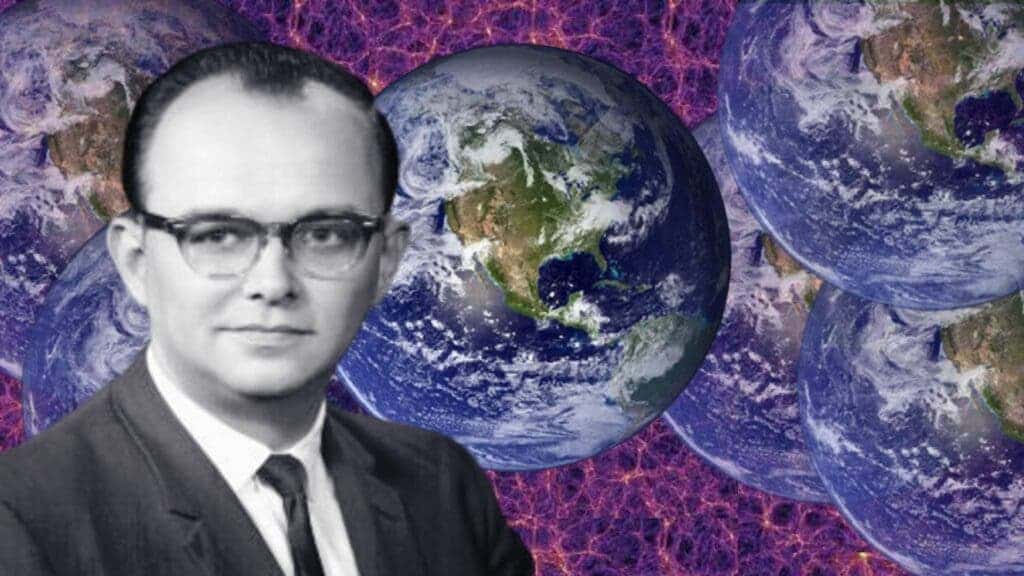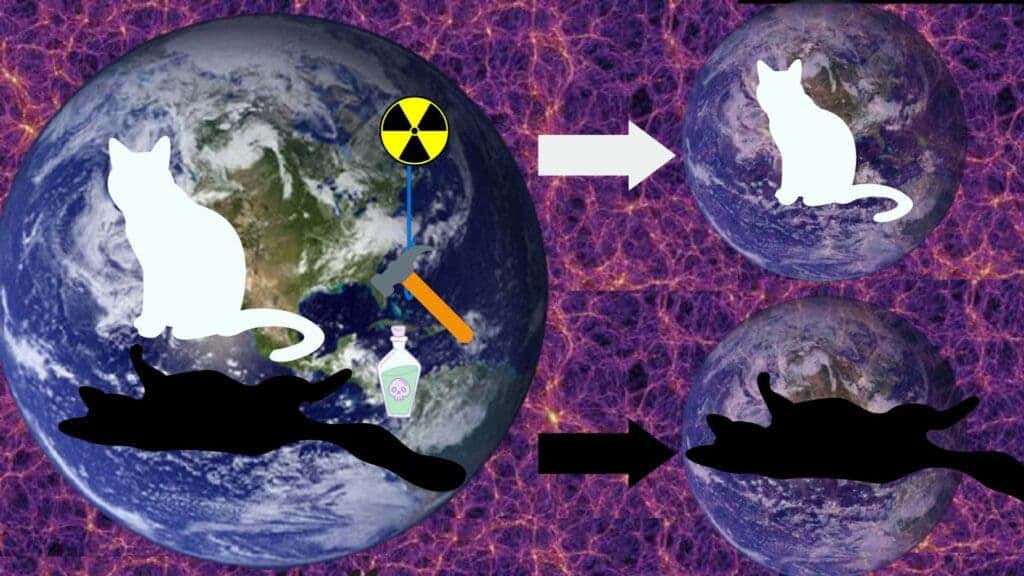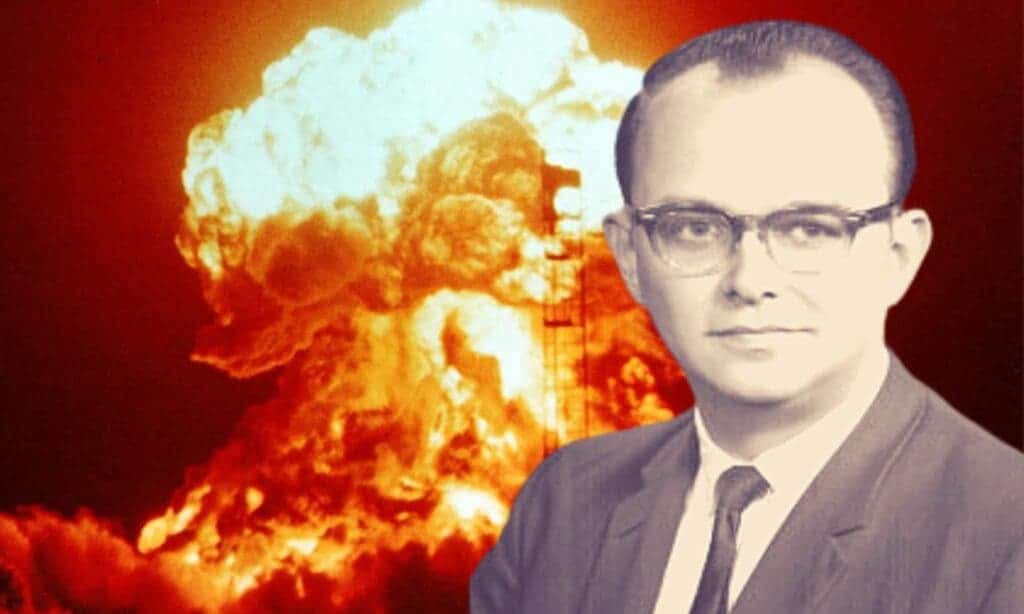Hugh Everett III is famous as the man who devised the many-worlds interpretation of quantum physics.
Everett’s theory concerns a mysterious puzzle that lies at the heart of quantum physics and suggests that measurement causes the universe to branch out into infinite different versions, all with the tiniest of differences. This may sound like pure science fiction, but the idea is supported by the mathematics of quantum mechanics.
The rejection of the concept would lead Everett to leave physics to pursue mathematics in the military and industry. A heavy drinker and smoker, he passed away at just 51 years of age.
Despite the fact it is not the consensus, many physicists still prefer the many-worlds interpretation of quantum physics over alternatives. Everett would not live to see the respect earned by his fellow physicists for the idea of “many worlds” or the incredible success that the idea would have in popular fiction.

Everett’s Journey Into Physics
Everett was born in 1930 and was raised around Washington D.C. initially by his mother, and then later by his father Hugh Everett Jr, and his stepmother. He attended St. John’s College High School before moving to the Catholic University of America graduating in 1953 with a degree in chemical engineering.
After Everett received a National Science Foundation fellowship, the budding mathematician continued his studies at Princeton. It was here in 1953 that Everett took his first introductory course in quantum mechanics.
In a 2007 article for Scientific American, Peter Bryne says that Everett’s journey to many worlds was kick-started in 1954 as he drank sherry with Charles Misner, a fellow Princeton student. The two began to discuss the counter-intuitive nature of quantum physics, and the young physicist began to consider the idea of many worlds as a solution to a lingering problem.
What is the Many Worlds Interpretation of Quantum Physics?
Ever since the inception of quantum physics in the 1920s, the so-called collapse of superposition–when a quantum system can be described as existing in potentially contradictory states–has troubled researchers.
The states of a system describe the possible values it can take. So if a coin is considered a physical system it can take two states–heads or tails.
In quantum physics, these states are described by wave mathematics. Because waves can overlap in what is known as a wavefunction, it means that a quantum system can theoretically exist in a superposition of multiple states simultaneously.
This affects subatomic particles like electrons and photons and describes qualities such as their velocity or spin. It isn’t seen on a macroscopic or “everyday” scale. But, a macroscopic hypothetical example is perhaps the easiest way to think about it.
A good way of picturing this is with Erwin Schrödinger’s infamous Schrödinger’s cat thought experiment. This sees a cat placed in a box with a diabolical device–a lethal poison that is released only if an atom within the device decays.
The box is sealed for an hour, enough time for the atom to possibly decay. But, because atomic decay is a quantum process, and thus completely random, there is no way to tell if the poison has been released.
This means that, if we treat the cat, box, and device as a quantum system it is possible to describe it as a superposition of states. And in this case, those states are “dead” and “alive.”
Its contradictory state is only resolved when the experimenter opens the bow–analogous to taking a measurement on the system. This causes the superposition to collapse–a process also called decoherence–and resolve into a single state.
But, quite what it is about measurement that causes this collapse has remained a mystery. This would come to be known as the “measurement problem.”
Everett’s suggestion of “many worlds” takes a very different approach. It posits the idea that the wavefunction doesn’t collapse at all.
Instead, when a measurement is made on a quantum system, the wavefunction grows to envelop the measurement equipment, the experimenter and eventually the entire Universe.
In effect, this means framing the many-worlds interpretation of quantum physics with the Schrödinger’s cat thought experiment there is no wavefunction collapse.
Each possible state of a quantum system exists in its own universe, separated from the rest.
“From the viewpoint of the theory, all elements of a superposition (all ‘branches’) are ‘actual,’ none any more ‘real’ than the rest,” Everett wrote in a thesis produced on the interpretation.

Instead of opening the box and resolving a state in which the cat is dead or alive, the experimenter opens the box to discover if she is in a universe in which the cat survived or a universe in which it died. Thus, Everett solves the measurement problem by doing away with decoherence altogether.
There is of course a consequence to this. Quantum systems are not large systems like cats in boxes, they actually concern particles on a subatomic level. This means every particle interaction creates a nearly unfathomable amount of worlds.
Consider the act of flicking on a light for instance. To emit 60 Joules a second a light bulb must blast out about 1.8 x 1020 photons per second.
Each of these photons would have billions of possible paths, each of which would have its own universe. Just considering the possible combinations in this situation suggests an unfathomably large number of worlds born in this one very mundane act.
Considering every possible quantum event in the Universe this quickly swells the number of created worlds to something approaching infinity. This is troubling to physicists and is perhaps the reason the many-worlds concept has never trumped the wavefunction collapse idea of quantum physics suggested by the widely accepted Copenhagen interpretation.
Indeed, when released in 1957, Everett’s paper on the many-worlds interpretation was met with almost complete indifference from the physics community.
Early quantum theorist and Everett’s academic adviser at Princeton John Wheeler had many discussions with the physicist about his theory. In a 2006 interview, Wheeler remarked: “[Everett] was disappointed, perhaps bitter, at the nonreaction to his theory. How I wish that I had kept up the sessions with Everett. The questions that he brought up were important.”
Everett would meet with Niels Bohr, another prominent quantum physicist in 1959 several times over a period of six weeks. He would also perfect a technique to search for optimum solutions to complex problems–the Everett algorithm. But, despite this, Everett was done with quantum physics research for good.
He didn’t even return to research in the 1970s when his concept finally began to gain traction. This doesn’t mean Everett rested on his laurels, however.
After Many Worlds

Everett would earn his doctorate from Princeton in 1957, a year after he had begun to work for the Pentagon. This employment saw him conduct important work such as the calculation of mortality rates that could potentially arise as a consequence of radioactive fallout resulting from a nuclear war.
He would advise officials in both the Eisenhower and Kennedy administrations regarding the selection of hydrogen bomb targets and the development of delivering a nuclear strike via missiles, submarines and planes.
Everett’s work and its terrifying implications may well have persuaded world leaders that a nuclear war would result in “mutually assured destruction.” Perhaps it even swayed officials who were considering preemptive strikes an option, that instead, a perpetual stand-off was a preferable approach to nuclear conflict.
Everett would go on to found several companies, including, in 1964, Lambda Corporation, which developed mathematical models for anti-ballistic missile systems and nuclear wargames.
In 1971 he devised a Bayesian computer program capable of learning from experience to assess possible outcomes which would be used to develop strategies for tracking incoming ballistic missiles.
As the years progressed, Everett’s heavy drinking and smoking began to take their toll. He was an unsympathetic character to colleagues, one of whom later recalled that Everett was cold and logical but had no time for human concepts like civil rights.
Most damningly perhaps, was the fact that Everett barely knew his children Elizabeth and Mark. As a teenager, the latter would find Everett dead in his bed on July 19, 1982, at the age of 51.
Mark, who would go on to become the lead singer for the band the Eels, believes that the discovery of his father’s lifeless body was the first time he had touched him.
Everett’s daughter, Elizabeth, would go on to take her own life in 1996. After her death as the result of an overdose, a note was discovered in her purse which said she had gone to join her father in another universe.
Many Worlds in Popular Culture
It isn’t just physicists that have embraced the idea of many worlds. Storytellers across a range of mediums have adopted the concept as a powerful storytelling device.
At the end of 2021, Spider-Man: No Way Home would use the many-worlds idea–albeit labelling it as a “multiverse” which is quite a different concept in science–to allow Tom Holland’s Peter Parker to meet previous incumbents of the role, Tobey Maguire and Andrew Garfield, and team up to tackle some familiar villains.
The film would go on to become the fifth highest-grossing film of all time and its themes have been given a horrific twist in the Sam Raimi-directed Doctor Strange in the Multiverse of Madness earlier this year.
Also on the silver screen this year, many-worlds was given an irreverent twist in the Michelle Yeoh starring Everything Everywhere All at Once. In the movie, an unlikely action hero accesses the skills of her counterparts from alternative universes to combat a multiversal foe with familial connections.
No medium of fiction has embraced the concept of many worlds quite as wholeheartedly as comic books, however. Veteran comic book writer Mark Waid who has written characters for DC Comics and Marvel including the Justice League, Spider-Man, The Avengers, and The Flash, explained to ZME Science why comic book fans have fallen in love with the idea of “many worlds.”
“They provide new ideas. After eighty years of stories largely featuring the same heroes, it’s insanely difficult to find ideas that have not been done before,” Waid says. “There have been, and this is true, more stories told about Batman than about any other fictional hero in human history. Multiverse versions of Batman allow for new, fresh stories.”
One of the original concepts of many worlds in comics came about in 1961 in the pages of the DC Comics published Flash issue 123 in which Barry Allen vibrated from his own world–Earth 1–to one in which his predecessor Jay Garrick still operated as the Flash. Jay’s world was dismissively labelled “Earth-2.”
This introduced to DC comics the concept of “infinite Earths” which would be popular throughout the 60s, 70s, and 80s, with meetings between the Justice League and their Earth-2 counterparts the Justice Society occurring every year. The characters were even able to journey to a world occupied by their writers in which they were simply comic book characters.
This was until 1986 and an event called “Crisis on Infinite Earths” by Marv Wolfman and George Perez, which rolled all these Earths into one. In the early 2000s, Waid who currently writes Superman/Batman: World’s Finest for DC Comics was part of a move to bring back “infinite Earths” albeit under a new moniker–Hypertime.
“From Crisis on Infinite Earths on through the 1990s, every single DC ‘event’ story made the DC Universe smaller by creating more restrictions and rules. No more parallel worlds. No more easy time travel. Everyone’s superpowers had the same origins. Stuff like this. And it made me nuts,” Waid explains. “Superhero comics aren’t about rules, they’re about flying. Hypertime was an attempt to open some doors rather than close them.
“I will always love DC’s Earth-One/Earth-Two dichotomy. Simple, easy to explain, DC’s ‘many worlds’ kicked off of the whole concept.”
In his 2010 biography of Hugh Everett III, Peter Byrne describes the physicist’s affection for science fiction. Byrne speculates that the idea of parallel worlds likely intrigued Everett long before he formalised his interpretation of quantum physics.
It’s a testament to Everett’s legacy that just as early sci-fi inspired real science, his scientific theory has inspired sci-fi tales for subsequent decades. Thus, millions of science fiction fans, cinema-goers, and comic book readers have thrilled at the concept pioneered by Everett, likely without even knowing his name.
This article originally appeared in 2022 and was republished with some small updates.


